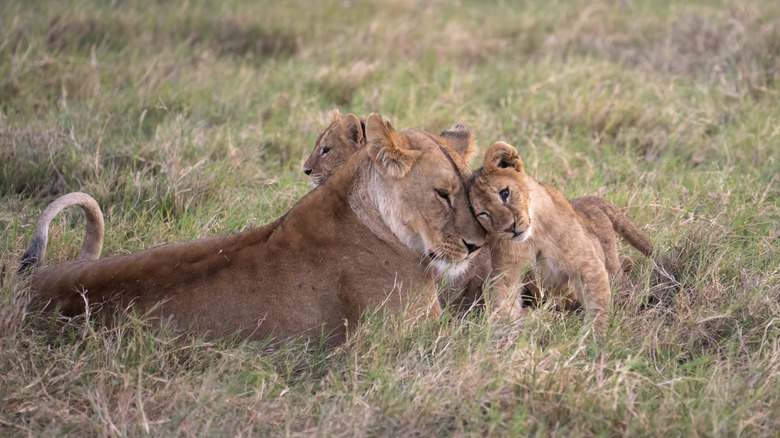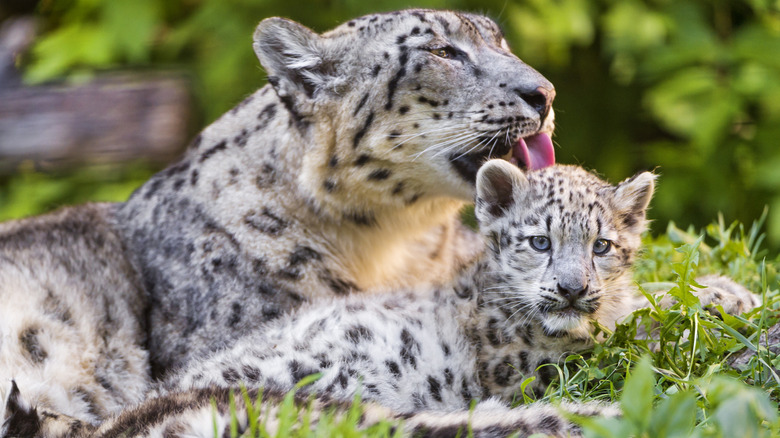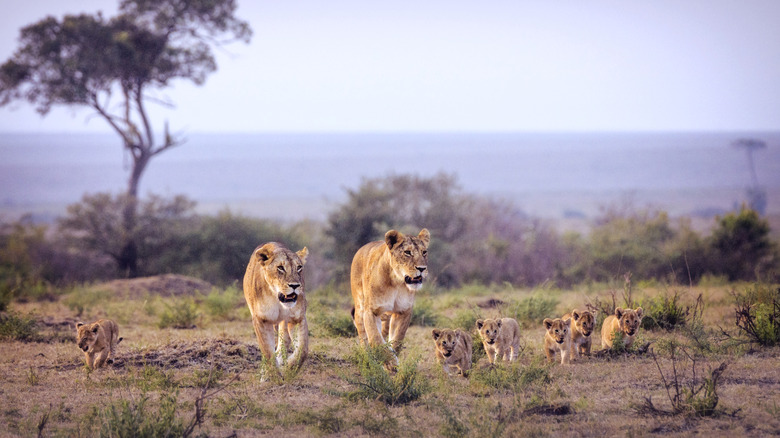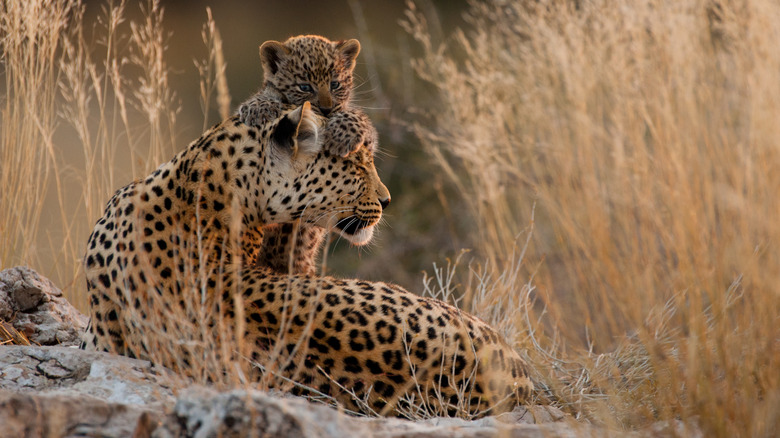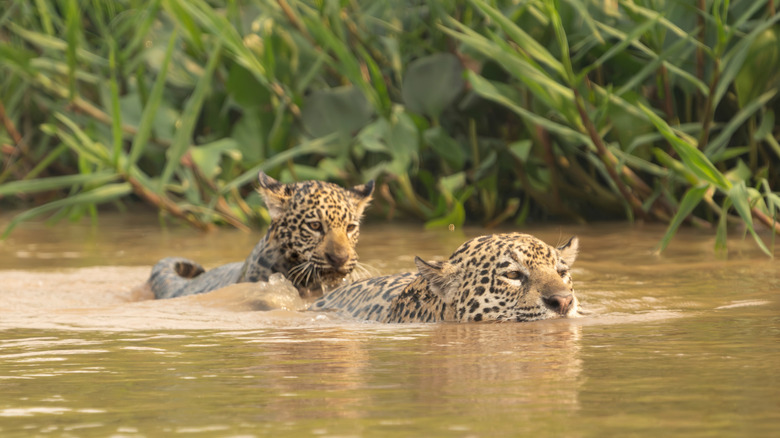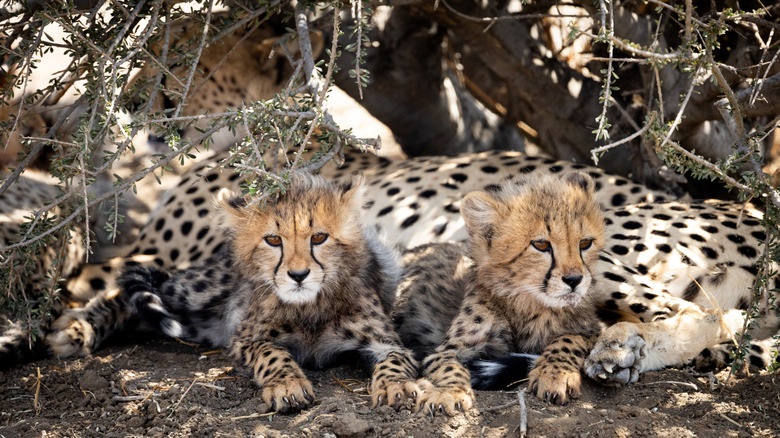The Best Big Cat Moms In The Wild
A parent's priority to protect their children is crucial for a healthy and happy upbringing. Yet, when it comes to parenthood in the animal kingdom, the rules can be a bit different. While many creatures co-parent, not all do, and often, it is up to the mother to raise their young and prioritize their safety over their own. Throughout the animal kingdom, you can find many examples of great moms, from the best bird mothers that will have you "aww"-ing to some incredibly patient dog moms.
When it comes to felines, many examples exist of mothers going above and beyond for their young. From the smallest domestic fluffball to the largest predator in the Sahara, observing life through the actions of a protective cat mother gives much insight into the challenges and triumphs that come with the important role of matriarch. With 41 species of felines, numerous examples of cats exhibiting exceptional maternal instincts can be observed in the wild, especially among the big cats.
Snow leopards keep their children close to prepare them for the world
While the snow leopard covers a vast territory, spanning over 1.2 million square miles across Asia and Eurasia, their numbers are low, ranging between 2,710 and 3,386 mature felines in the wild. This makes the role and hard work of mother snow leopards all the more vital in helping ensure the big cat continues to thrive. A snow leopard carries her young for 93 to 110 days before giving birth. The cubs are unable to see for the first seven days, with their next major milestone occurring after two months when the cubs can begin eating solid food.
At three months, they are ready to start exploring with their mother after months of her hunting solo and bringing home food. For the next 18 to 22 months, the family moves together as a unit, with the mother helping her growing fluffballs adjust to life across the rocky terrains and ravines they call home. With the skills taught to them, the cubs are ready to start their own families, with the females able to care for their own children at around three years old.
Lions work together as a community to protect their young
The saying "it takes a village to raise a child" could not be more apt when it comes to lion mothers. While the first few weeks of a cub's life are spent hidden away, with their mother keeping a watchful eye over them, after this period, they are introduced to a crèche, which is like a community-run nursery. Here, the cubs grow up alongside their cousins and under the vigilant eyes of many mothers, as a means to protect them from male lions looking to take over the pride or predators like hyenas.
The female lionesses within the pride spend their entire lives in a creche, while the males are kicked out of the pride around the age of two. Lions are the only big cats that raise their young and form strong bonds that last a lifetime in groups that can number as many as 30. Not only do lion mothers teach their children how to socialize and hunt, but they also play an essential role in every aspect of their kids' lives, passing on the same values and skills to the next generation. The remarkable maternal skills of lions have made them one of the most adaptable and crucial apex predators in the African savannas they inhabit.
Leopards are great single moms
Leopards are classified into eight subspecies and are found across Africa and Asia. The largest of these subspecies, which boasts the highest population, is the African leopard. Despite the extensive range they cover, these big cats are facing declining numbers; the various species are now classified as ranging from vulnerable to critically endangered. The limited populations paint the leopard mother as a solitary figure, a role in which she, thankfully, excels.
A dutiful leopard mother will hide her cubs in various locations, such as bushes or high up, to go out and hunt to provide food for them until they are around 11 months old and able to join her. The cubs will stay with their mothers for the first two years of their lives, learning all the vital tools of survival. This time is crucial to the development of a young leopard; conservationists will go to great efforts to reunite a cub with its mother if it is lost.
Despite the hard work of the leopard matriarch, the threats that the species faces, including famine due to dwindling prey and other predators, result in a higher mortality rate. A cub has a 50% chance of reaching an age where it can branch off and start building a family of its own.
Jaguar mothers will flirt with threats to save their young
Found across South America, with the largest populations residing in the rainforests of Brazil, the jaguar encounters unique challenges from other big cats due to the area's biodiversity and varied terrain. Among the many threats, one of the biggest to cubs is male jaguars looking to establish their own families with new offspring.
To save their young, a mother will employ the "hide and flirt" method. A mother will hide her young when an impending male threat comes, lure them away, and in some cases even mate with them. This technique can create ambiguity about fatherhood, thereby lowering the chances of aggression from a male toward the young.
Jaguar mothers follow a similar timeline with their cubs as most other cats, raising cubs until they are two years old before allowing them to venture off on their own. During this time, they teach their young unique skills to help them thrive. Unlike other big cats, the jaguar uses rivers to stay cool in the rainforests and to sneak up on prey. This means the matriarch jaguar has a broader skill set to pass on to her cubs, enabling them to excel in thick forests where other predators struggle.
Cheetahs show how motherhood in the animal kingdom is unpredictable
The fastest land mammal in the world, the cheetah, is renowned for its speed, clocking up to 70 mph in under three seconds. The big cat has also become a fan favorite at many zoos, as the cheetah can form a bond with support dogs. Cheetah moms face many of the same challenges that many big cats face in the wild. Some, even, have faced other big cats in an effort to protect their young.
Cheetah moms have been given a bad rap. Despite their bravery, the infant mortality rate for cheetah cubs can be as high as 90%, with some never raising a single litter to adulthood in their lives. However, cheetah mothers work as hard as any other big cat to raise their young, teaching them how to adapt to their environment and become skilled hunters themselves by the time they are two years old. Yet, the threats of predators, poaching, and a shrinking environment and food sources all contribute to the high cub mortality rate. If given the chance, a mother cheetah would stand tall alongside other big cats to help raise her young.
From the snow leopard to the cheetah, all big cat mothers work hard and must face many threats. For animal lovers, their dedication and sacrifice should inspire and remind people why wildlife conservation is essential for ensuring future generations can be inspired by these big cat mothers' exceptional maternal instincts.
